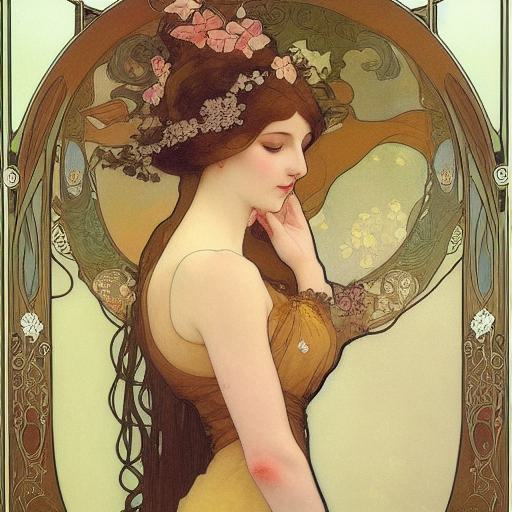Start creating with an AI prompt
With the technique of AI image generation with tool like Midjourney and Stable Diffusion, only if we understand how the image is affected by the AI prompt, we can create awesome artworks and be transported to a captivating world where the ethereal beauty of a painting unfolds.
The prompt “a painting of a woman with flowers in her hair” serves as a visual foundation, directing the AI image generators to portray a female figure adorned with floral elements. The flowers become a central motif, symbolizing natural beauty and femininity, contributing to the overall allure of the artwork.
The reference to “art nouveau painting” sets the stylistic tone, inspiring the AI image generators to incorporate the sinuous lines, organic motifs, and graceful forms synonymous with the Art Nouveau movement. This influence is reflected in the composition, adding an element of elegance and artistic sophistication to the image.
The mention of “Alphonse Mucha” invokes the spirit of this renowned artist, prompting the AI image generators to imbue the artwork with the characteristic aesthetics associated with Mucha’s work. The flowing lines, intricate detailing, and balanced proportions are all elements that pay homage to Mucha’s artistic legacy, resulting in a visually captivating representation.
The descriptors “elegant,” “artistic,” and “long dress” shape the overall impression of the artwork. The AI image generators incorporate these qualities into the woman’s attire, capturing the essence of grace, creativity, and refinement. The long dress becomes a focal point, exuding an air of sophistication and enhancing the overall visual impact of the painting.
Once the artwork is complete, it becomes a testament to the creative process and a reflection of our artistic vision. By utilizing design tool like Visual Paradigm Online, we can seamlessly integrate this stunning artwork into our design projects, presentations, or personal collections, expanding its reach and impact.
Different elements in Art Nouveau
In Art Nouveau imagery, floral decorations and female characters are indeed prominent and widely used. However, there are instances where other elements are employed to adorn characters or objects, each carrying its own symbolic meaning. Let’s explore some alternative decorative motifs in Art Nouveau and their significance:
- Whiplash Lines: One distinctive characteristic of Art Nouveau is the use of sinuous, curvilinear lines resembling whiplashes. These flowing lines often serve as decorative elements, accentuating the organic and dynamic nature of the artwork. They represent the rhythm and harmony found in nature.
- Insects and Animals: Art Nouveau artists frequently incorporated depictions of insects, such as dragonflies, butterflies, and beetles, as well as various animal motifs. These creatures symbolize metamorphosis, the ephemeral nature of life, and the interconnectedness of all living beings.
- Symbols of Transformation: Art Nouveau embraced the idea of transformation and renewal. Symbols such as cocoons, buds, or chrysalises were utilized to represent the potential for growth, change, and rebirth. These motifs conveyed a sense of optimism and the continuous cycle of life.
- Mythological and Symbolic References: Art Nouveau drew inspiration from mythology and symbolism. Decorative elements such as peacock feathers, which symbolize beauty and immortality, or the serpent, representing wisdom and eternal life, were frequently incorporated into artworks, adding layers of meaning and intrigue.
By incorporating these diverse decorative elements, Art Nouveau aimed to celebrate the harmony and interconnectedness of the natural world, human creativity, and the ever-evolving spirit of life.
Reasons behind “Elegant” of the works
Art Nouveau’s enduring elegance can be attributed to a combination of historical and cultural influences. The movement emerged as a response to the rapid industrialization and mass production of the late 19th century. Artists and designers sought to counter the impersonal nature of mechanized production by reintroducing the craftsmanship and individuality of handmade objects. This rejection of industrialization was influenced by the ideals of the Arts and Crafts Movement, which emphasized the integration of art into everyday life.
The Arts and Crafts Movement played a significant role in shaping Art Nouveau, as both movements shared a commitment to artisanal craftsmanship and a disdain for the dehumanizing effects of mass production. Within the Art Nouveau movement, artists placed great emphasis on quality and attention to detail, leading to the creation of elegant and refined works of art. The meticulous craftsmanship employed by artisans and the focus on handcrafted elements contributed to the overall sense of elegance associated with Art Nouveau.


